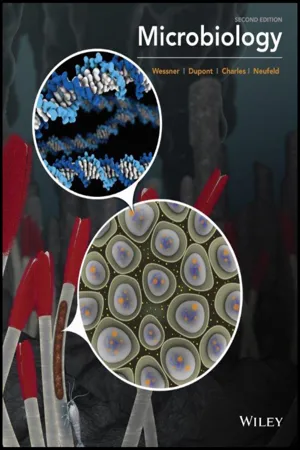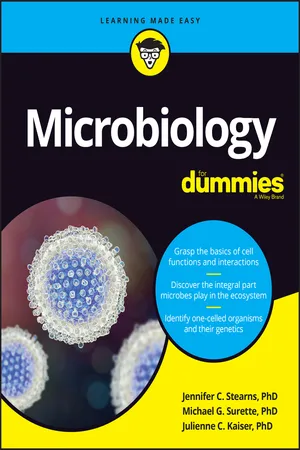Biological Sciences
Spiral Shaped Bacteria
Spiral-shaped bacteria, also known as spirilla, are a type of bacteria characterized by their helical or corkscrew shape. They are classified as Gram-negative bacteria and can be found in various environments, including water and soil. Some spiral-shaped bacteria are pathogenic and can cause diseases in humans and animals, while others are beneficial and play a role in processes such as nitrogen fixation.
Written by Perlego with AI-assistance
Related key terms
Related key terms
1 of 4
Related key terms
1 of 3
5 Key excerpts on "Spiral Shaped Bacteria"
- Julius Kreier(Author)
- 2022(Publication Date)
- Routledge(Publisher)
Actinomyces species, among others), in squares, and in irregular clusters. In addition to those already described, groupings of cells include: rosette clusters, flexible gliding clusters, and tightly packed films. It seems reasonable to assume that any possible form, shape or arrangement of bacterial cells may exist somewhere in nature awaiting discovery.However, in spite of our continuing discovery of new shapes and groupings of bacteria, the historic descriptions that were based primarily on observations after cells were cultivated in the laboratory under conditions designed to promote maximum growth rates continue to have value both because of their practicality in rapid identification of pathogens and because of an already existing literature that uses those descriptions. Figure 15.1 illustrates some of the more common shapes and groupings of pathogenic bacteria.Figure 15.1. An illustration showing the more common shapes and arrangements of many pathogenic bacteria.SYNOPSIS OF NUTRITION, METABOLISM, AND GROWTH
Most bacteria consist of about eighty percent water and twenty percent solids and they require moisture to grow. As with all living organisms, bacteria must absorb nutrients, metabolize them in order to derive energy to synthesize new cell structure and then excrete the by-products of metabolism. The cells must have suitable nutritional sources for supplying their requirements for carbon, hydrogen, nitrogen, oxygen, phosphate, sulfur, and several mineral ions such as calcium, cobalt, copper, iron, magnesium, manganese, potassium, sodium, zinc, and others. Most organisms including most bacteria also require additional organic growth factors such as amino acids, proteins, sugars, and vitamins. They require as a nutrient any cellular component they cannot synthesize.- eBook - ePub
The Tangled Tree
A Radical New History of Life
- David Quammen(Author)
- 2018(Publication Date)
- William Collins(Publisher)
One source places its standing population at three octillion individuals, a number that looks like this: 3,000,000,000,000,000,000,000,000,000. They vary in shape and in size—interestingly in shape, drastically in size. A bacterial cell, on average, is about one-tenth as big as an animal cell. At the upper end of the range is Thiomargarita namibiensis, an odd thing discovered on the sea floor near Namibia, its cells ballooning up to three-quarters of a millimeter in diameter, stuffed with pearly globules of sulfur. At the lower end of the range is Mycoplasma hominis, a tiny bacterium with a tiny genome and no cell wall, which manages nonetheless to invade human cells and cause urogenital infections. Bacterial shapes, as I’ve mentioned, range through rods, spheres, filaments, and spirals, with variations that in some cases represent adaptations for movement or penetration. It turns out that their geometries, notwithstanding the efforts and convictions of Ferdinand Cohn, are unreliable guides to their phylogeny. Shape can be adaptive, but adaptations can be convergent as well as ancestral. Roundness may be good as a hedge against desiccation. Elongation as a rod or filament seems to help with swimming, and a flagella definitely does. Filamentous bacteria that are star shaped in cross section, recently discovered in a wonderfully named substance called “mine-slime,” deep in a South African platinum mine, may profit from all their surface area by way of enhanced absorption in nutrient-poor environments. The twisting motion of spirochetes, such as the ones that cause syphilis and Lyme disease, evidently allows them to wiggle through obstacles that other bacteria can’t easily cross, such as human organ linings, mucous membranes, and the barrier between our circulatory system and our central nervous system—a fateful degree of access - eBook - ePub
- Dave Wessner, Christine Dupont, Trevor Charles, Josh Neufeld(Authors)
- 2016(Publication Date)
- Wiley(Publisher)
Treponema pallidum cells are long, thin spirals. However, because many bacterial species have similar morphologies, and because environmental conditions and stresses can sometimes cause changes in bacterial morphology, physical appearance is seldom conclusive for identifying bacterial species.For many bacterial species, like E. coli, individual cells typically remain separate from each other. The cells of other bacteria stay physically connected after they divide. For example, the rod-shaped cells of Bacillus anthracis, the cause of anthrax, and the spherical cells of Streptococcus pyogenes, the cause of strep throat, often are seen in long chains. In contrast, Staphylococcus cells tend to form clusters rather than chains (see Figure 2.1 ). Some bacteria do not exhibit regular shapes, but may exhibit highly variable cell morphologies. These bacteria are referred to as pleiomorphic . Examples of pleiomorphic bacteria include members of the genus Mycoplasma, which do not make a cell wall and, as a result, do not have a regular shape ( Figure 2.2 ) .Figure 2.2.These bacteria are very small (about one-tenth the size of E. coli cells). Lacking a cell wall, the cells may have an irregular shape—some may appear sphere-like, others more rod-shaped. Although cells may stick together, Mycoplasma are not multicellular.Pleiomorphic MycoplasmaCONNECTIONS As we will discuss in Section 6.5 , most bacteria can be removed from solutions by passing the solutions through fine filters. Because of their small size and lack of a cell wall, mycoplasma cells often are not retained by these fine filters.Some bacteria grow in more complex multicellular arrangements ( Figure 2.3 ) . Soil bacteria of the Actinomycete group grow as irregularly branching filaments called hyphae that are composed of chains of cells. Hyphae can form three-dimensional networks called mycelia that can rise above the substrate, penetrate down into soil, or both. A distinctive multicellular arrangement found in cyanobacteria is the formation of smooth, unbranched chains of cells called trichomes - eBook - ePub
- Jennifer Stearns, Michael Surette(Authors)
- 2019(Publication Date)
- For Dummies(Publisher)
In this chapter, we give a bird’s-eye view of the structure of microbial cells. Then we go into some of the most important structures in detail. We discuss major differences between microbes — for instance, what differs between eukaryotic and prokaryotic microorganisms, as well as things that all cells have in common.Seeing the Shapes of Cells
We know that prokaryotic cells come in many different shapes and sizes because we can look at them under a microscope. A description of the shape of a cell is called the cell morphology. The most common cell morphologies are cocci (spherical) and bacilli (rods). Coccibacillus are a mix of both, while vibrio are shaped like a comma, spirilla are shaped like a helix (a spiral, sort of like a stretched-out Slinky), and spirochetes are twisted like a screw. Figure 4-1 shows these common cell morphologies.Although prokaryotes are unicellular organisms, their cells can be arranged in a few different ways, like chains or clusters, depending on how the cells divide:FIGURE 4-1: Cell morphologies.- Cocci bacteria that divide along a single plane form small chains of two cells called diplococci or long chains of multiple cells called streptococci.
- Cocci bacteria can also divide along multiple planes to form tetrads (two planes), cubelike sarcinae (three planes), or grapelike clusters called staphylococci (multiple planes).
- Similarly to the cocci, rod-shaped bacteria can divide to form double-celled diplobacilli or longer chains called streptobacilli.
- eBook - ePub
- Britannica Educational Publishing, Kara Rogers(Authors)
- 2010(Publication Date)
- Britannica Educational Publishing(Publisher)
Vibrio cholerae , which causes cholera. Other shapes of bacteria include the spirilla, which are bent and rebent, and the spirochetes, which form a helix similar to a corkscrew, in which the cell body is wrapped around a central fibre called the axial filament.The bacterium Streptococcus mutans is an example of a spherical (coccus) bacterium. This species of bacteria commonly aggregates into pairs and short chains . David M. Phillips/Visuals UnlimitedBacteria are the smallest living creatures. An average-size bacterium, such as the rod-shaped Escherichia coli , a normal inhabitant of the intestinal tract of humans and animals, is about 2 micrometres (μm; millionths of a metre) long and 0.5 μm in diameter, and the spherical cells of Staphylococcus aureus are up to 1 μm in diameter. A few bacterial types are even smaller, such as Mycoplasma pneumoniae , which is one of the smallest bacteria, ranging from about 0.1 to 0.25 μm in diameter; the rod-shaped Bordetella pertussis , which is the causative agent of whooping cough, ranging from 0.2 to 0.5 μm in diameter and 0.5 to 1 μm in length; and the corkscrew-shaped Treponema pallidum , which is the causative agent of syphilis, averaging only 0.15 μm in diameter but 10 to 13 μm in length. Some bacteria are relatively large, such as Azotobacter , which has diameters of 2 to 5 μm or more; the cyanobacterium Synechococcus , which averages 6 μm by 12 μm; and Achromatium , which has a minimum width of 5 μm and a maximum length of 100 μm, depending on the species. Giant bacteria can be visible with the unaided eye, such as Titanospirillum namibiensis , which averages 750 μm in diameter, and the rod-shaped Epulopsicium fishelsoni
Index pages curate the most relevant extracts from our library of academic textbooks. They’ve been created using an in-house natural language model (NLM), each adding context and meaning to key research topics.
Explore more topic indexes
Explore more topic indexes
1 of 6
Explore more topic indexes
1 of 4




